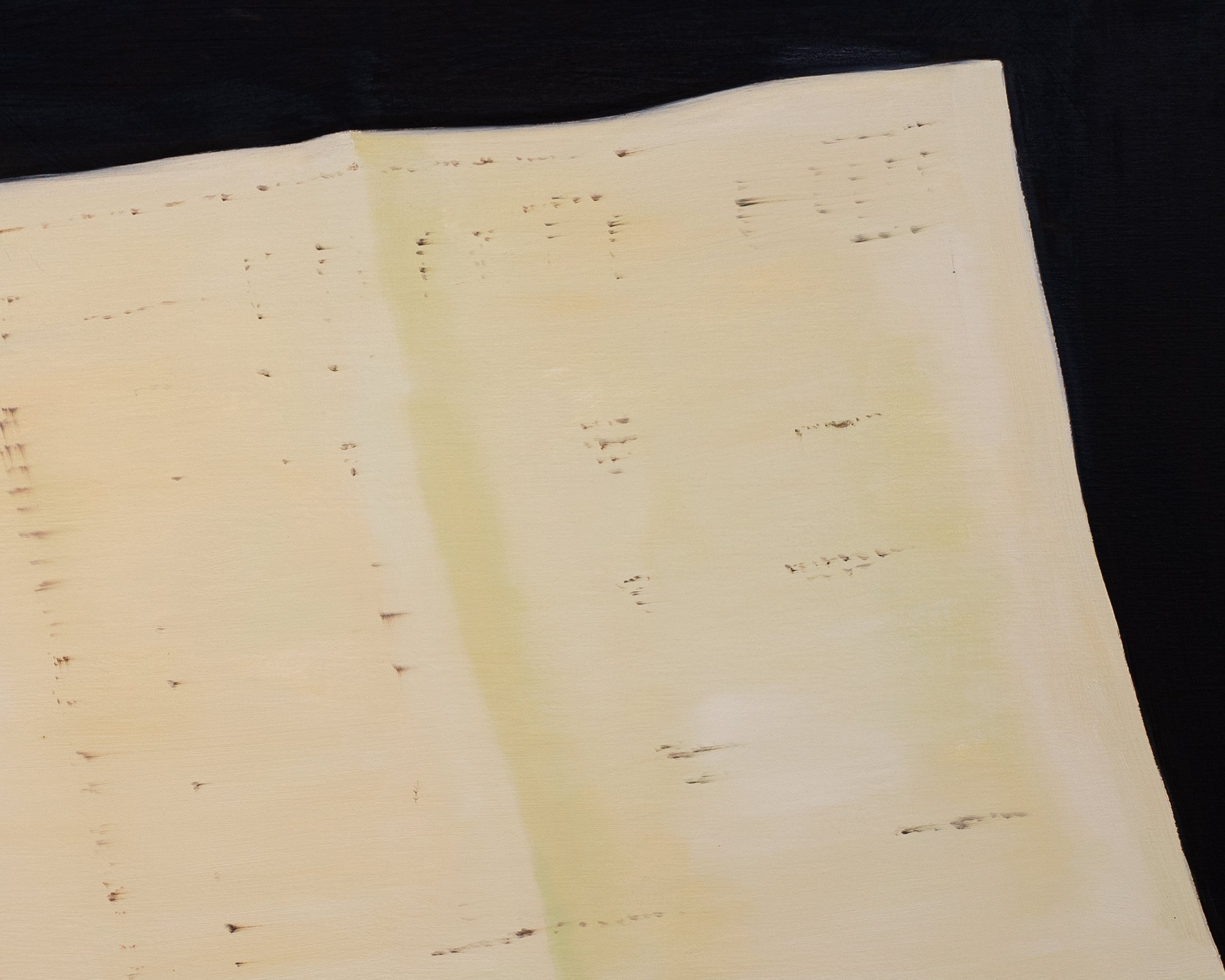The Note G, 2022
The Note G, 2022
Oil on linen
76 x 122 cm (30 x 48 in)
The Note G (2022) is inspired by Note G, written in 1843 by Ada Lovelace, who is regarded as the world’s first computer programmer. Tan Mu reinterprets this algorithmic manuscript, originally designed for the Analytical Engine—a mechanical general-purpose computer envisioned by Charles Babbage—unveiling the history of computing and the often-overlooked role of women in its development. Note G is the final annotation in Sketch of the Analytical Engine Invented by Charles Babbage, a work by Luigi Federico Menabrea. Lovelace's notes, which included a method for the engine to calculate Bernoulli numbers, made a groundbreaking contribution that not only pushed the Analytical Engine beyond its original conception but also laid the foundation for modern computer programming. Moreover, she envisioned the potential of computers to handle complex tasks beyond numerical computation, such as generating music and creating graphical patterns—an astonishingly forward-thinking insight into the possibilities of computing. Lovelace's legacy remains a cornerstone of our understanding of computer programming, inspiring generations of computer scientists. To this day, her pioneering work continues to shape modern computing and highlights the profound impact of women in science and mathematics.
Q: Could you discuss the background and inspiration behind this piece?
Tan Mu: The inspiration for this work comes from my exploration of the early history of algorithms and computer programming, particularly the significant contributions made by women in this field. In my research, I discovered that many of the early tasks related to program design and data input were actually carried out or even led by women, yet these narratives were often suppressed or diminished. Therefore, I wanted to highlight and bring attention to this overlooked history through my work. The page depicted in the painting is a note that Ada Lovelace added while translating Charles Babbage’s work. In this note, she proposed the concept that equations could evolve into intelligent algorithms and even imagined that computers could perform complex tasks, such as generating music and creating graphic patterns, not just numerical calculations. Her visionary insights deeply moved me, which is why I decided to document this pivotal moment in painting. When I was researching, I was saddened to learn that Ada Lovelace passed away at the age of 36, which is similar to my current age. Yet, when we look across time, her thinking has had a profound impact on the development of computer science and has directly shaped the world we live in today.
Q: Why did you choose to focus on Ada Lovelace’s annotated page?
Tan Mu: Although this page is merely an annotation in the book, its influence far surpasses that of the book itself. It annotates the future evolution of this equation into an intelligent algorithm, laying the foundation for the concept of algorithmic programming and automatic computation. In my work, I chose to emphasize this page. While there are no figures directly depicted in the painting, it still reflects how decisions made by individuals in specific circumstances can have far-reaching effects. When painting, I intentionally blurred the content of Note G. Although the specific equation or calculation steps are unclear, this mirrors how the story of women in computing has, over time, been obscured. The black background in this painting, similar to the visual language I use in my other works focusing on objects, directs attention to the object itself, inviting the viewer to look at it in a way that amplifies its significance in history. Through focusing on this annotated page, I hope to capture this historical moment and pay tribute to Ada Lovelace.
Q: Your works often depict the development of algorithms. Why do you think this development is especially important and worthy of being recorded?
Tan Mu: My practice explores the evolution of computational power, both in terms of processing power and algorithms, reflecting the relentless pursuit of greater capability. Progress in modern society—from breakthroughs in materials to technological advancements—has all been driven by breakthroughs in computational power. I’ve created numerous oil paintings around this subject, from material breakthroughs like Silicon (2021, 2023), Antimony (2020), Logic Circuit (2022), and Mapping (2021) to the development of computers, such as DEC's PDP-10 (2021), Quantum Computer (2020), Quantum Gaze (2023), and works like The Binary Dream (2024) and Punched Card 1, 2 (2022) that reflect my focus on both the development of computers and the often-overlooked role of women behind this progress, as seen in Note G. I believe it’s crucial to record the development of computational power and algorithms through painting, as it transforms these milestones into physical oil paintings, creating a future archive. It’s similar to how we look back at 1997, when Deep Blue’s victory in chess was a milestone in the expansion of AI (as seen in Checkmate 2022). Similarly, the exploration of algorithms could trace back 200 years, meaning that, from today’s perspective, we are currently at a pivotal moment that could define the next 50 years of development. I trace these technological milestones, illustrating how the rapid expansion of computational power is reshaping society and cognition, inviting viewers to rethink the impact of computational power and algorithms on our past, present, and future.




